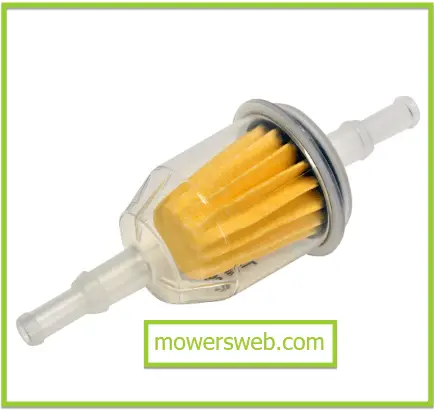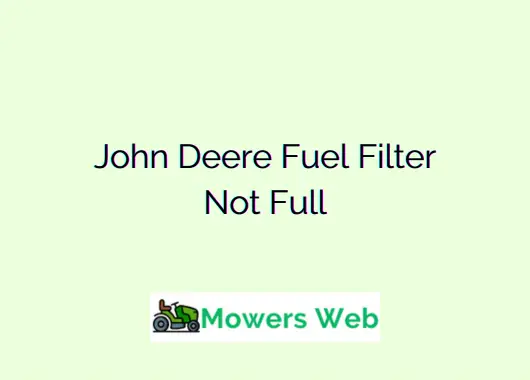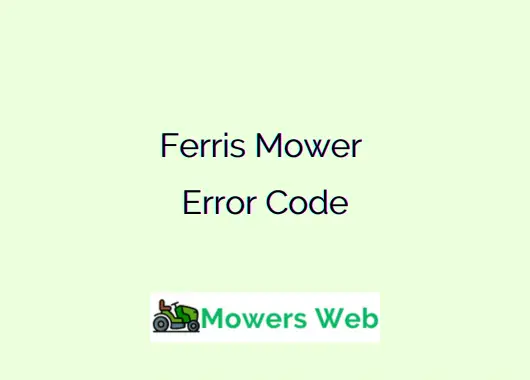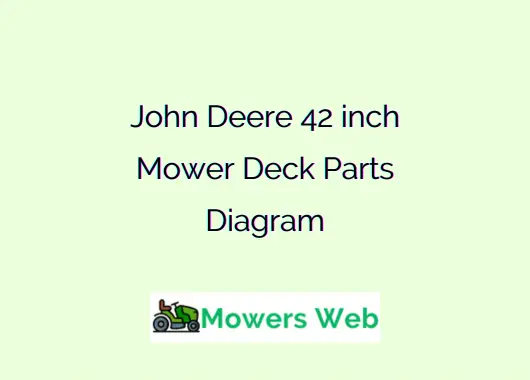When it comes to maintaining the performance of your John Deere equipment, ensuring a properly functioning fuel system is crucial.
One common issue that users may encounter is a fuel filter that is not full.
In this post, we will explore the reasons behind this problem and provide you with troubleshooting steps and solutions to resolve it effectively.
So, let’s dive in and understand how to tackle the issue of a John Deere fuel filter not being full.
The Importance of a Full Fuel Filter
A fuel filter acts as a protective barrier, preventing contaminants from entering the engine and causing damage.
It ensures that only clean fuel reaches the combustion chamber, optimizing the performance and longevity of your John Deere equipment.
A full fuel filter is essential for efficient fuel filtration and smooth operation.

John Deere Fuel Filter Not Full
1. Clogged Fuel Filter
One of the primary reasons for a fuel filter not being full is a clog in the filter itself.
Over time, the filter can accumulate dirt, debris, and sediment, hindering the flow of fuel.
This blockage prevents the fuel from reaching the filter’s upper chamber, resulting in an incomplete fill.
2. Air Leak in the Fuel System
An air leak in the fuel system can disrupt the fuel supply and prevent the filter from filling up properly.
Leaks can occur in various parts of the system, such as fuel lines, connections, or fittings.
Even a small leak can introduce air into the system, affecting the fuel filter’s performance.
3. Faulty Fuel Pump
A malfunctioning fuel pump may not generate enough pressure to fill the fuel filter adequately.
A weak or failing pump can lead to reduced fuel flow, causing the filter to remain partially empty.
It is crucial to ensure that the fuel pump is in good working condition to maintain a full fuel filter.
4. Incorrect Installation
Improper installation of the fuel filter can also contribute to the problem.
If the filter is not correctly aligned or securely fastened, it may not receive an adequate supply of fuel.
This can result in a fuel filter that does not fill up completely, affecting the overall fuel delivery system.
Read 10 Common John Deere 185 Hydro Problems(With Solutions)
Troubleshooting Steps to Fix the Issue
1. Inspect the Fuel Filter
Begin by examining the fuel filter for any signs of clogging or damage. If you notice excessive debris or sediment,
it may be necessary to clean or replace the filter. Inspect the filter housing as well to ensure it is secure and properly sealed.
2. Check for Air Leaks
Thoroughly inspect the fuel lines, connections, and fittings for any signs of air leaks. Use soapy water or a suitable leak-detection solution to identify any bubbles or leaks.
Address any leaks found by repairing or replacing the affected components.
Read Best Oil for John Deere Riding Mower(Top 3 Oils)
3. Examine the Fuel Pump
Test the fuel pump’s pressure output using a fuel pressure gauge. If the pressure is below the recommended range, it may indicate a faulty fuel pump that requires repair or replacement.
Consult the equipment’s manual or a certified technician for assistance in diagnosing and resolving fuel pump issues.
4. Verify Proper Installation
Double-check the fuel filter’s installation to ensure it is correctly aligned and securely fastened.
Make sure all connections are tight and leak-free. If any discrepancies are found, adjust the installation accordingly to allow for proper fuel flow.
Read John Deere 345 Fuel Pump Problems(3 Quick Ways To Fix)
How to Fix John Deere Fuel Filter Not Full
1. Clean or Replace the Fuel Filter
If the fuel filter is clogged or damaged beyond repair, clean it thoroughly or replace it with a new one.
Follow the manufacturer’s instructions for cleaning or installing a new filter correctly.
2. Fix Air Leaks in the Fuel System
Address any air leaks in the fuel system by repairing or replacing the affected components.
Ensure that all connections are properly tightened and sealed to prevent further leaks.
3. Repair or Replace the Fuel Pump
If the fuel pump is found to be faulty, consult a qualified technician to repair or replace it.
A properly functioning fuel pump is essential for maintaining adequate fuel flow and a full fuel filter.
Read John Deere Low Viscosity Hy-Gard Equivalent(9 Best)
4. Ensure Correct Installation
Check and verify that the fuel filter is correctly installed, aligned, and securely fastened.
Proper installation is vital to ensuring optimal fuel flow and a completely filled fuel filter.
Read John Deere 790 Problems(5 Quick Ways To Fix)
John Deere Fuel Filter Problems
1. Engine Performance Issues
A clogged fuel filter can restrict the flow of fuel to the engine, resulting in reduced performance.
You may notice a decrease in power, sluggish acceleration, or difficulty maintaining consistent speeds.
2. Difficulty Starting the Engine
If your fuel filter is severely clogged, it can make it challenging to start your vehicle or equipment.
The engine may crank for an extended period before starting or may not start at all.
3. Stalling or Misfiring
A clogged fuel filter can cause intermittent stalling or engine misfires. This occurs when the engine doesn’t receive an adequate fuel supply, leading to inconsistent combustion and performance issues.
4. Rough Idling
A clogged fuel filter can disrupt the smooth operation of the engine while it is idling. You may experience rough idling, where the engine feels shaky or unstable when at a standstill.
Read 10 Common John Deere S240 Problems(With Solution)
5. Reduced Fuel Efficiency
If your fuel filter is clogged, it can affect the fuel flow to the engine, leading to decreased fuel efficiency.
You may notice that you’re covering fewer miles per gallon or that your equipment is consuming fuel more rapidly than usual.
6. Sudden Loss of Power
In severe cases of a clogged fuel filter, you may experience a sudden loss of power while driving or operating your equipment.
The engine may struggle to maintain speed or require higher RPMs to function.
Read Can I Use Trufuel in My Lawn Mower(5 Benefits)
What Happens If Fuel Filter Is Blocked?
| Consequences of a Blocked Fuel Filter |
|---|
| Engine Performance Issues |
| Difficulty Starting the Engine |
| Engine Stalling or Misfiring |
| Fuel Pump Damage |
| Reduced Fuel Efficiency |
| Engine Damage |
Read Riding Mower Making Noise When Blades Are Engaged(Fixed)
How Do You Get Air out of Fuel Filter?
Prepare
Ensure you have the necessary tools and safety equipment, such as gloves and safety glasses.
Locate the Bleeder Screw
Find the bleeder screw on the fuel filter housing. It is typically a small screw or valve located at the top or side of the filter.
Open the Bleeder Screw
Using a wrench or screwdriver, slowly loosen the bleeder screw to allow air and fuel to escape.
Be cautious not to completely remove the screw; just loosen it enough to create a small opening.
Pump the Primer or Turn the Ignition
Depending on the type of fuel system, you may need to pump the primer bulb (if equipped) or turn the ignition key to the “ON” position without starting the engine. This will engage the fuel system and help purge the air.
Read How to Start a Toro Lawn Mower without Primer(step by Step)
Monitor the Bleeder Screw
As you pump the primer or engage the fuel system, keep an eye on the bleeder screw.
You should start to see a mixture of air and fuel coming out of the screw. Allow the air to escape until you observe a steady flow of fuel without air bubbles.
Tighten the Bleeder Screw
Once you have a steady flow of fuel without air, carefully tighten the bleeder screw back into place. Ensure it is snug but not overly tightened.
Verify Fuel System Operation
After securing the bleeder screw, start the engine and monitor its operation.
Check for any abnormal behavior or signs of air in the fuel system. If necessary, repeat the bleeding process to remove any remaining air.
Read Can I Use Trufuel in My Lawn Mower(5 Benefits)
John Deere Fuel System Troubleshooting
| Step | Troubleshooting Action | Description and Tips |
|---|---|---|
| 1 | Check Fuel Level | Ensure an adequate fuel supply in the tank. |
| 2 | Inspect Fuel Filters | Check for dirt or clogs; replace if necessary. |
| 3 | Examine Fuel Lines | Look for cracks, leaks, or kinks; repair or replace as needed. |
| 4 | Verify Fuel Quality | Ensure clean, uncontaminated fuel is used. |
| 5 | Check Fuel Pump Operation | Listen for a buzzing sound from electric pump upon ignition. |
| 6 | Test Fuel Pressure | Use a gauge to measure pressure at different points in system. |
| 7 | Inspect Injectors | Check for leaks; consider professional cleaning/testing. |
| 8 | Check Air Filters | Ensure the air filter is clean and in good condition. |
| 9 | Verify Throttle Operation | Ensure proper throttle adjustments and linkage operation. |
| 10 | Check for Vacuum Leaks | Inspect hoses and connections for leaks. |
| 11 | Examine Carburetor (if applicable) | Ensure proper operation and cleanliness; adjust if needed. |
| 12 | Inspect Fuel Tank | Look for debris, sediment, or water; clean if necessary. |
| 13 | Scan for Error Codes | Use diagnostic tools to identify electronic system issues. |
| 14 | Consult the Manual | Follow equipment’s manual for specific troubleshooting steps. |
| 15 | Seek Professional Assistance | If unresolved, consult a qualified technician or service center. |
Read John Deere Fuel Filter Not Full(3 Quick Ways To Fix)
How to Change John Deere Fuel Filter
Changing the fuel filter on a John Deere involves a few straightforward steps. Here’s a video explanation of how to do it:
Read John Deere 345 Fuel Pump Problems(3 Quick Ways To Fix)
Final Remarks
A full fuel filter is crucial for the efficient operation of your John Deere equipment.
By understanding the causes behind a fuel filter not being full and following the troubleshooting steps and solutions provided in this article, you can address the issue effectively.
Regular maintenance and proactive measures will help maintain a properly functioning fuel system and extend the lifespan of your John Deere equipment.
FAQs
How often should I replace the fuel filter on my John Deere equipment?
It is recommended to replace the fuel filter according to the manufacturer’s guidelines or during routine maintenance intervals, typically every 200–300 operating hours or once per season.
Can a clogged fuel filter cause engine performance issues?
Yes, a clogged fuel filter can restrict fuel flow, leading to reduced engine performance, power loss, and potential stalling or misfiring.
Are there any specific signs that indicate an air leak in the fuel system?
Some common signs of an air leak in the fuel system include rough idling, difficulty starting the engine, poor fuel efficiency, and visible fuel leaks around connections or fittings.
Can I clean a clogged fuel filter instead of replacing it?
Cleaning a clogged fuel filter may be possible in some cases. However, it is generally recommended to replace the filter to ensure optimal performance and prevent potential damage to the fuel system.
What should I do if I suspect a faulty fuel pump?
If you suspect a faulty fuel pump, it is best to consult a certified technician who can perform a proper diagnosis and recommend the necessary repair or replacement.




